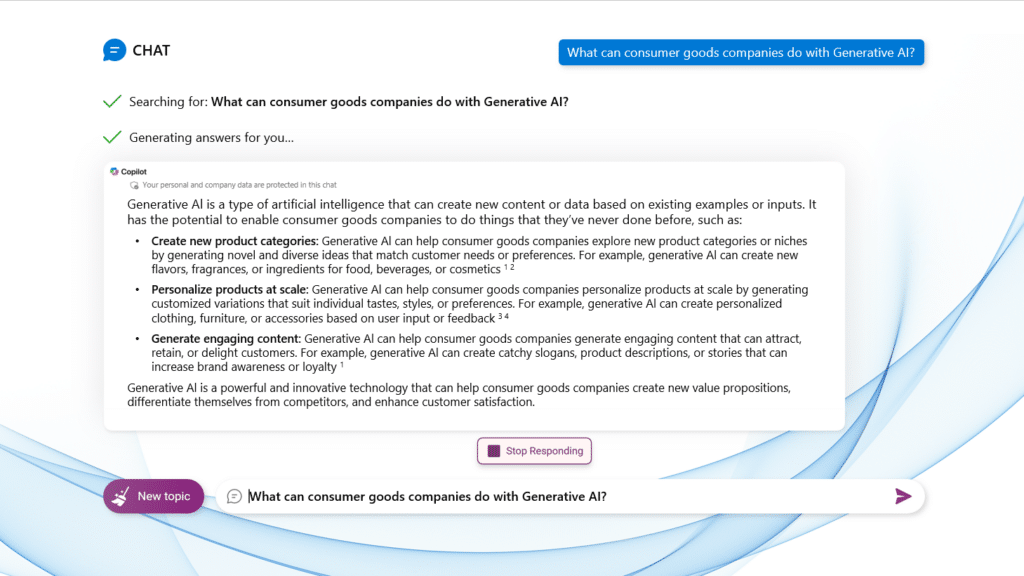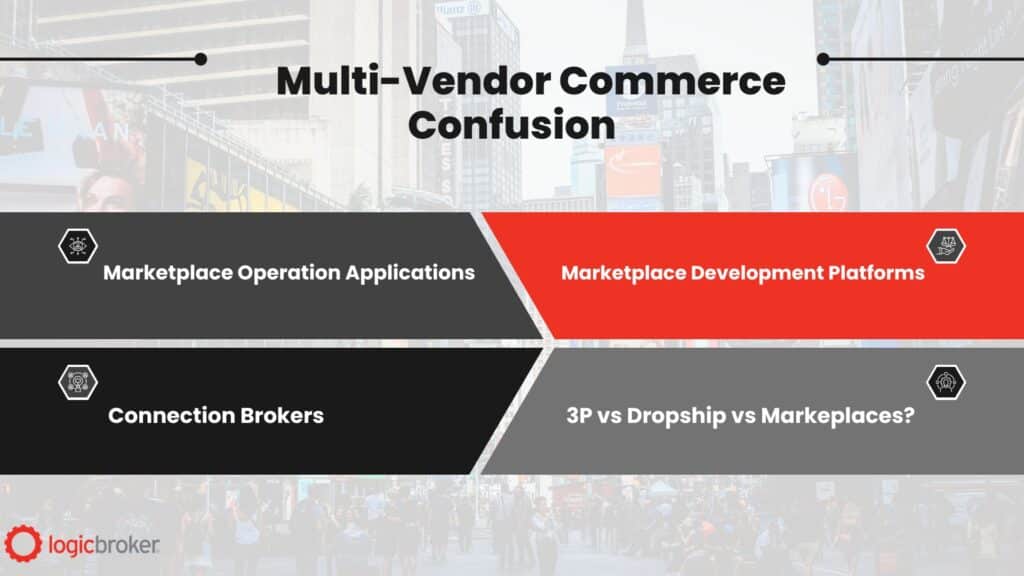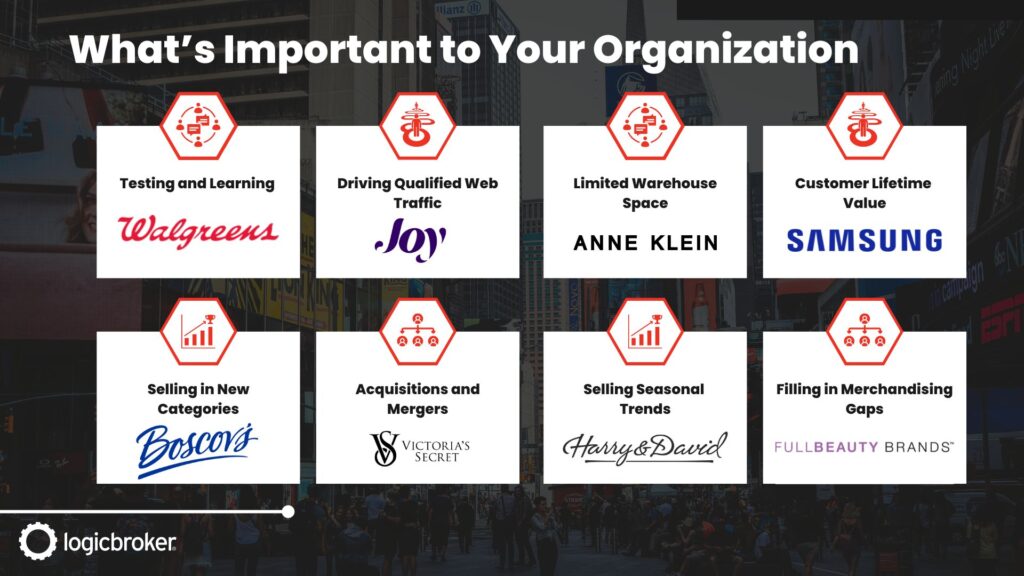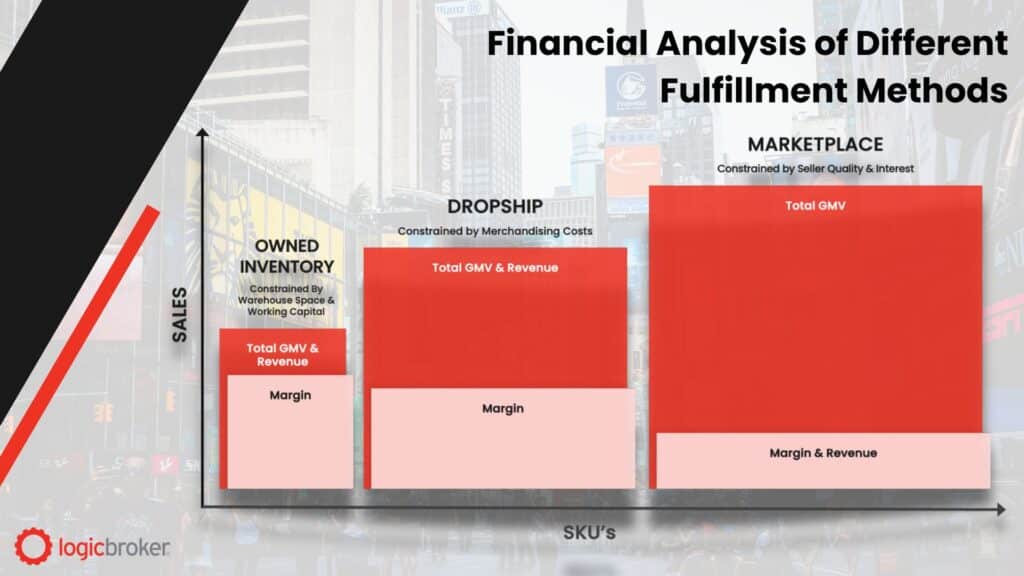 Logicbroker & Microsoft Team Up In NYC To Dive Into The Future Of Multi-Vendor Commerce
Logicbroker & Microsoft Team Up In NYC To Dive Into The Future Of Multi-Vendor Commerce
By Jager Robinson | September 26, 2024
As Q4 and retail’s notoriously busy season rapidly approaches, a group of eCommerce’s most influential executives gathered in New York City on September 19 at Microsoft’s Times Square Innovation Hub to discuss the future of Multi-Vendor Commerce (MVC) and how organizations are utilizing MVC to exceed consumer and financial expectations.
Spearheaded by Sue McMahon, Global Partner Strategy Lead, Retail & Consumer Goods at Microsoft, Logicbroker’s NYC event brought together executives across all verticals and featured presentations from McMahon, Mark Detelich, President of Logicbroker, and Steve Norris, VP of Digital Commerce. To close out the event, Logicbroker held a roundtable discussion on how those gathered can best capitalize on new technologies like AI and MVC innovations to better orchestrate their eCommerce programs.
The conversation turned to a few specific points on how to best lead in the era of AI, how MVC can work for your organization, where organizations stand on the MVC Maturity Curve, what business problems modern MVC can solve, and how best to consider the tradeoffs & financial implications of MVC.
Leading in the Era of AI
As a global leader in AI innovation and investment, McMahon showcased how Microsoft is doubling down on generative AI to reshape retail. Specifically, McMahon highlighted how Co-Pilot and other generative AI models are able to fully network into existing systems to make more informed purchasing decisions, consolidate all client information, and work smarter in everyday tasks.
While ChatGPT and OpenAI have been involved in the space since the beginning, McMahon’s discussion centered on how generative AI isn’t just a language tool but rather a management tool for all communications. Dozens of organizations, with Microsoft’s help, are embracing Co-Pilot’s ability to filter through communications and double down on data organization to better utilize their workforces’ time, rather than rely on thousands of manhours for fairly menial tasks.
Perhaps the most vital aspect of AI’s continued evolution is the ability for sales and merchandising reps to “speak the language of the client.” McMahon shared how generative AI models can now speak a “variety of languages and slang” to better represent your target demograpgic(s). Generative AI models can also accurately map target key phrases and keywords, help fill assortment gaps, and assist in creating compelling product content.
After fielding many questions, the conversation turned to how AI is impacting Multi-Vendor Commerce and what the implications of an AI-powered MVC platform would look like.
Clearing the Confusion Around Multi-Vendor Commerce
eCommerce has a definitions problem. With thousands of terms thrown around like Connection Broker, Marketplace Development Platform, Dropship Manager, and more, the Logicbroker team helped clear general confusion about what makes a program Multi-Vendor Commerce and how organizations can utilize modern MVC to best orchestrate their eCommerce programs.
At its core, Multi-Vendor Commerce is a strategy to enable assortment growth and reach new audiences through the orchestration of multiple fulfillment models and suppliers. Traditional MVC platforms allow users to see real-time orders, order updates, inventory, financials, and product content by connecting to external suppliers and brands without the requirement of capital expenditure for holding the inventory.
Logicbroker has taken this concept one step further with what we’ve dubbed modern Multi-Vendor Commerce.
Because of MVC’s inherent ability to combine and unify an organization’s eCommerce processes, Logicbroker has introduced a new wave of simplification for retailers and brands. Instead of relying on teams of employees to onboard, inspect, and update suppliers and product content, our platform automates all essential communication and fulfillment processes to allow for rapid speed-to-market.
In the real world, what this looks like is pre-MVC platform a retailer would have to individually orchestrate a dropship, owned inventory, and marketplace program. These individual programs were typically run by individual teams that then required a whole slate of communications to just get a product onboarded or a supplier integrated.
With modern MVC, expanding assortment becomes as simple as asking your MVC platform to onboard a new supplier. Or, as frictionless as already finding them in their MVC platform’s portal to onboard in minutes.
These rapid speed-to-market tools Logicbroker offers play a vital role in ensuring a retailer’s ability to not only adopt new fulfillment models and reach new customers but also expand assortment without the dangers of owned inventory or rising shipping costs.
The common theme heard during the event was about understanding MVC as this: “It’s not just about selling more. It’s about selling smarter and with more flexibility.”
The Data Behind the Business Problem
Data is everything. And, unfortunately, it’s not just everything but its all knowing. During the event, executives were curious about how MVC handles the rapidly evolving data requirements seen throughout eCommerce.
Typically, retailers and brands spend thousands of hours a month, or even a week, going through piles of data looking at warehouse space, seasonal trends, merchandising gaps, and more. The increasing need to not only have a way to sift through data but to simply have a place to see this data is growing year over year.
Part of the confusion around MVC was not understanding how the Logicbroker Platform has the unique ability to touch on all data points simultaneously. Everything from a retailers OMS, eCommerce storefront, ERPs, PIMs, invoices, product content, return labels, inventory availability, and scorecarding is done right in the Logicbroker portal.
This accessibility is the reason Logicbroker clients tend to not only thrive during the tenure with the organization but also expand, as those people previously put to data sifting can now easily switch to merchandising or sales related activities.
However, not everyone is at the stage where full automation makes the most sense for their organization, which is why Logicbroker introduced the MVC Maturity Curve during the event.
The Multi-Vendor Commerce Maturity Curve
Logicbroker adopted a comprehensive maturity curve to showcase where retailers are in comparison with those who the industry considers mature eCommerce operators. This maturity curve, showcased by Logicbroker’s VP of Digital Commerce, Steve Norris, is broken down into four stages: lagging, state of the market, leading, and visionary. However, these stages aren’t the discussion but rather the frame.
No matter where you are on this curve, the MVC maturity curve is a simple tool to visualize where you are and where you want to go.
For example, early-stage programs tend to focus on expanding assortments, while more mature programs optimize financial integrations and reporting. Neither approach is wrong, because that’s not the point. Every unique organization has a set of goals and challenges they’d like to tackle.
This boils down to the idea that multi-vendor commerce is no longer a one-size-fits-all approach. As businesses mature along the MVC Maturity Curve, their program builds more complex, integrating advanced features like customizable reporting, multi-warehouse inventory management, and enhanced financial integrations. No one stage of the curve is bad, rather how a business defines its goals and priorities determines where they stand and where they can go.
Luckily for those not in attendance, Norris recently published a blog focusing on how organizations have progressed along this maturity curve and how each stage impacts businesses across all verticals.
The Business Problems MVC is Solving Today
Logicbroker is proud of the work we’ve put into building a more perfect MVC solution for our clients. Like every piece of software, adopting an MVC platform isn’t as easy as just saying “Okay, it’s done.”
For all of our clients from Walgreens to Boscov’s to Samsung, we had lengthy discussions on business problems they wanted to solve and how we could help. Walgreens’ main focus became how to better test and learn from new products, suppliers, and product catalogs onboarded.
Samsung, on the other hand, had a deep desire to stop being primarily viewed as a supplier for larger marketplaces like Amazon and instead wanted to round out their public offerings, keep customers on Samsung.com, and gather more first-party data. Now, instead of customers turning to Amazon to buy accompanying products, they can visit Samsung to purchase everything from a new TV to a new headset, gaming console, video games, and more.
During the event, the Logicbroker team challenged individuals in the room to ask themselves what are their own business goals. Understandably, almost every retailer ended up having slightly different goals in mind.
However, one thing remains constant, the underlying problem is almost always alleviated by adopting a platform that works for you, rather than in spite of you. With Multi-Vendor Commerce, selling in new categories, acquisitions & mergers, selling seasonal trends, and filling merchandising gaps are part of the package.
The Financial Implications of Multi-Vendor Commerce
Traditionally, leading organizations utilize MVC to orchestrate their owned inventory, dropship, and marketplace models. As you can see in our slide, these fulfillment models have vastly different margins, GMV potential, and sales expectations. Because of this, those in the room began a lengthy discussion on the difference between dropship and marketplace, and what separates them in the eCommerce landscape.
Executives in attendance showcased how their marketplace operations differed from their peers’ dropship programs, giving everyone a better sense of how products can move effortlessly across these fulfillment models.
The Logicbroker team showcased how Logicbroker, is capitalizing on these dramatically different fulfillment models to allow organizations to continuously, effortlessly, and frictionlessly shift products across its client’s networks to better grow revenue.
The above graph highlights how a traditional big box retailer may approach MVC fulfillment. With an emphasis on maintaining margins and growing revenue, this retailer would see something like toothpaste, which has a very low cost to own, as the prime target for owned inventory fulfillment. While the margins are low, the cost of storage and purchasing negates any risk. As this retailer moves down the chart, a product like a couch becomes too cost-prohibitive to source and store themselves and instead, they’d choose to dropship that product through their online storefront.
These discussions during the event engrossed many products, and even focused on several clients in the room, to better help those present understand the advantages of a MVC platform. In addition, these conversations coincided with McMahon’s AI discussion as generative AI is getting better and predictive analytics. AI plays a crucial role in automating workflows, improving supplier management, and optimizing assortment decisions across multiple channels.
The effortless switch between B2B, D2C, 3P, owned inventory, and more gives MVC retailers a leg up in an industry where not only are margins tight but trends are everything.
Didn’t Get to Attend? Reach Out Today!
In today’s retail landscape, both modern MVC and AI are dramatically changing how retailers and brands capitalize on their target markets. Whether its assortment decisions, streamlining operations, or even just getting started remapping your fulfillment models, technology is here to help.
We know it’s tough to get to every event, but there is always an opportunity to sit down with your peers or a Logicbroker rep to dive into what your business goals and unique challenges are. What we learned during the event was that while everyone’s goals are different, the solutions can and will be found with just a little help.
We encourage each organization to explore the Multi-Vendor Commerce Maturity Curve in more detail. With this curve, begin mapping where you are, where you want to be over the next year, and how you can achieve your goals through effortless multi-vendor fulfillment. When you’re ready, a phone call with the Logicbroker team can make all the difference in contextualizing how your organization can best utilize a new process.
If you’re curious about how you can accelerate your multi-vendor strategy, let’s chat. Visit *** to reach a member of our team.
About Logicbroker
Logicbroker is a premier multi-vendor commerce platform that seamlessly connects trading partners regardless of integration types. Our modern solutions empower retailers and brands to take control of their customer experience by harnessing and analyzing vital first-party data, reducing inventory risk, and curating their expanded assortment. By improving the visibility into our client’s commerce programs, Logicbroker can better position retailers and brands for transformative growth.
As business needs and demand shift, Logicbroker provides the ability to quickly switch suppliers and product fulfillment between 3P to 1P and responsibly find new sources of inventory that uphold your brand integrity and meet your delivery promise. We work with mid-market and Enterprise manufacturers and retailers across a number of verticals including Health & Wellness, Home Improvement, Consumer Electronics, Toys & Babies, and Consumer Packaged Goods and service brands such as Samsung, Victoria’s Secret, The Vitamin Shoppe, Walgreens, Ace Hardware, and BBQGuys.
Modern dropship & marketplace solutions have never been so easy.
Are you ready to drive growth and gain unparalleled speed to market with a modern, scalable dropship or marketplace program? Fill out the form below to get in touch with our team:





